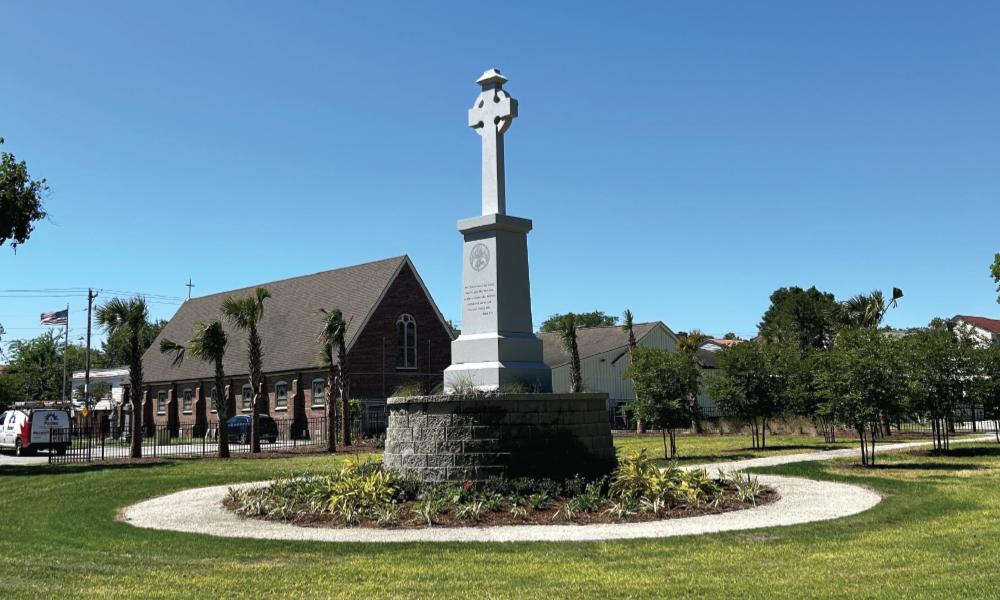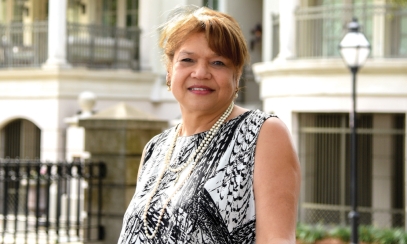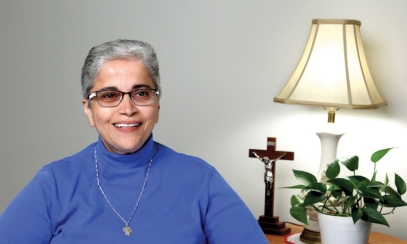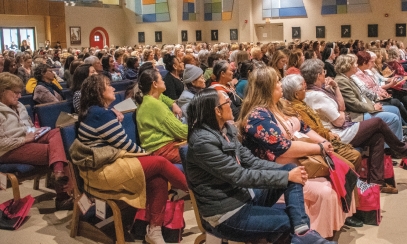
Historic St. John Cemetery Renewed and Restored
Neglect can kill a cemetery, and that is what happened to St. John on Coming Street in the heart of downtown Charleston.
Neglect can kill a cemetery, and that is what happened to St. John on Coming Street in the heart of downtown Charleston.
The Diocese of Charleston purchased a plot of land in 1843 and consecrated the ground so African American Catholics, free and enslaved, could bury their brothers and sisters. Since then, more than 1,000 souls have been laid to rest in St. John.
Desegregation, however, was not kind to the cemetery or the property around it.
In 1967, two historically Black churches — Immaculate Conception and St. Peter — were closed near the cemetery, and parishioners were merged into St. Patrick Church. Burial records from 1843-1882 were lost during the transfer.
Then Immaculate Conception Catholic School near the cemetery was shut down, and a blaze damaged buildings on the land. The structures were razed. And, it got worse.
The S.C. Department of Transportation used eminent domain to take a portion of the land to build the Crosstown Highway, according to records.
“For more than 20 years, the property remained vacant and unmarked. Gravestones were lost, destroyed or removed. Its history forgotten or overlooked, the diocese sought to sell the property in the 1990s,” according to a report by the Catholic Carolina Professionals (CCP).
“The neighborhood was a rough neighborhood,” said Frank Dirks, member of the CCP. “The cemetery was forgotten. The field was turned into a de facto parking lot,” he said.
He said it took action by concerned African Americans, and Calvary Episcopal Church that overlooks the cemetery, to alter the fate of the historic cemetery. In 1994, the Episcopal church prompted a study by the Chicora Foundation, which showed that the land was indeed a consecrated Catholic cemetery with about 1,000 people buried there. With the results of that study, the diocese decided not to sell the property and had a fence built around it.
Dirks, who said he lived not far from the cemetery, first learned about this forgotten field in 2019. He and the CCP knew they had to get involved.
“The Holy Spirit inspired us,” he said. “It is our obligation; it is our duty to remember the faithful departed.”
They got in touch with Karmin Meade, director of cemeteries for the diocese. She and her team were ensconced in a five-year plan to revitalize the eight diocesan cemeteries in their care. St. John was tended to weekly as years of neglect were peeled back and the beauty of the sacred space was restored one layer at a time.
“Covid delayed us but never diminished our commitment to this effort,” Meade said. “Frank Dirks and I were able to sit down with Bishop Robert E. Guglielmone, who has been a constant supporter of our cemetery revitalization efforts, to discuss future plans for St. John Cemetery specifically. The bishop and I shared our plans for St. John with Frank, who offered the assistance of Carolina Catholic Professionals in helping us realize our goals.”
The initial concept for a crucifix memorial was born in that meeting and additional funding was committed by the bishop for its design, fabrication and installation.
In March 2020, the CCP began raising funds, Dirks said. Those efforts brought between $75,000-$80,000 despite the pandemic.
“We have more than $200,000 between the diocese and Catholic Carolina Professionals dedicated to the cemetery,” Dirks said.
When the group encouraged Dominion Energy to remove its power poles from the grounds, the utility company did so willingly and then provided a grant of $15,000 toward renovation efforts. Dirks added that the good will and grace of the Holy Spirit truly is at work at St. John. Graces continued to flow when Meade put Southland Landscape Management in charge of reviving the grounds.
“Our team had made significant progress in restoring St. John and all of our cemeteries, but the historic cemetery really began to shine when Southland took on the heavy lifting,” Meade remarked.
Landscape plans were developed, shrubs and trees were pruned or removed and new irrigation, lighting, trees and shrubs were installed.
“David Schwartz with Southland has been an amazing partner,” she added. “He listened to our needs and embraced our vision. The result of our collaboration at St. John is a serene, park-like space that properly honors those who lie at rest there.”
A 19-foot obelisk of Jesus on the cross was installed at its center on Feb. 2 this year.
“Bishop Guglielmone chose the prayer that is inscribed on it,” Meade said.
The front inscription is from John 3:16: “For God so loved the world that he gave his only Son, so that everyone who believes in him might not perish but might have eternal life.” The inscription on the back comes from Micah 6:8, part of which is emblazoned on Bishop Guglielmone’s coat of arms: “You have been told, O mortal, what is good, and what the LORD requires of you: Only to do justice and to love goodness, and to walk humbly with your God.”
Not only is St. John Cemetery no longer forgotten, “it is now a beacon of hope to all who drive by on the Crosstown. You cannot pass through downtown Charleston without being touched by Jesus,” Meade said. “It is my hope that by honoring our dead we are also giving hope to the living.”
As a finishing touch, “the diocese installed four benches. Each one is dedicated to a Black Catholic parish, past and present, in our community,” Dirks said. “It is truly a memorial park, a place of reflection.”
It is also an opportunity for evangelization, he added, one that he believes motorists on the heavily traveled Crosstown Highway will see. As people drive past this hallowed ground restored, the crucifix clearly stands above the trees and is easily visible from the road. Those drivers will now see a well-groomed cemetery, Meade said.
The opening ceremony and blessing by Bishop Jacques Fabre-Jeune, CS, was held June 19 in conjunction with the diocesan Juneteenth 2023 celebration. The national theme this year was Perfecting Unity, to bring all Americans together to celebrate the common bond of freedom through recognition, observance and historical preservation. The renovation of these hallowed grounds exemplifies the meaning of the occasion.
And now, because of the dedication, passion and collaboration of local Catholics, the families and relatives of those buried at St. John Cemetery need never again worry about neglect of the faithful departed.
Watch St. John Cemetery: A silent witness to centuries of faith on the Diocese of Charleston YouTube channel.



